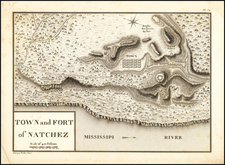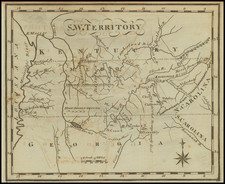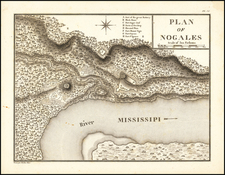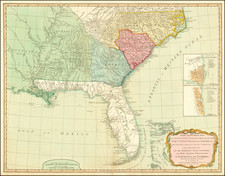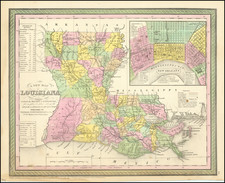This map covers the area between Lake Maurepas and Pensacola, encompassing the yet-to-be-formed Alabama Territory and all of the Mississippi Territory. It features detailed depictions of forts including Fort Barrancas, Fort Bowyer, Fort St. John, Fort St. Philip, and the Old Fort on Lake Pontchartrain. Additionally, it marks batteries on both ends of English Turn, two camps, and a battlefield situated between villages and New Orleans.
The map is highly detailed, with soundings, notes on the number of guns at several forts, and other fascinating annotations. It is one of the few printed War of 1812 battle plans and almost certainly the largest obtainable printed battle plan of New Orleans. This map is an essential acquisition for collectors of New Orleans and Gulf Coast history.
From Melish's Military and Topographical Atlas of the United States.
John Melish (1771-1822) was the most prominent American mapmaker of his generation, even though his cartographic career lasted only a decade. Melish was born in Scotland; he moved to the West Indies in 1798 and then to the United States in 1806. By 1811, he had settled in Philadelphia and published Travels through the United States of America, in the years 1806 & 1807, and 1809, 1810, & 1811, which was richly illustrated with maps.
Melish created several regional maps of the highest quality, as well as the Military & Topographical Atlas of the United States (Philadelphia, 1813, expanded 1815). The latter work is widely considered to be the finest cartographic publication to come out of the War of 1812.
By far his best-known work is his monumental map of the United States of 1816, Map of the United States with the contiguous British and Spanish Possessions. He began working on the map in 1815 and sent it to Thomas Jefferson for comment in 1816. Jefferson enthusiastically reviewed the map and returned it with his edits. Jefferson later hung an example of the map in the Entrance Hall of Monticello and sent it to associates in Europe.
Melish’s finished product was the first map of the United States to extend to the Pacific Ocean. After its publication in 1816, Melish ensured the map was as up-to-date as possible; it was reissued in 25 known states published between 1816 and 1823. The map captured the then rapidly changing geography of the United States, as well as various boundary disputes, treaties, and expansion.









![[Alabama, Mississippi, Arkansas, Louisiana and part of Tennessee and Western Florida] Amer. Sep. No. 56 Partie des États Unis](https://storage.googleapis.com/raremaps/img/small/93538.jpg)
